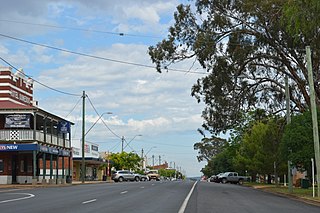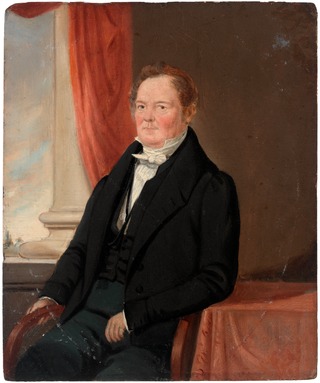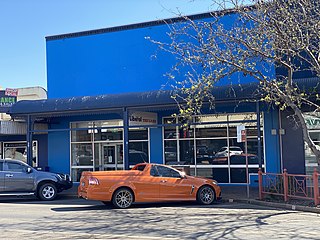
Dubbo is a city in the Orana Region of New South Wales, Australia. It is the largest population centre in the Orana region, with a population of 43,516 at June 2021.

Dunedoo is a village of 1,021 inhabitants situated within the Warrumbungle Shire of central western New South Wales, Australia. Dunedoo is well known to Australian travellers due to its distinctive name. The name is actually derived from a local Aboriginal word meaning "swan", which are commonly found in the area's lagoons.

Newell Highway is a national highway in New South Wales (NSW), Australia. It provides the major road link between southeastern Queensland and Victoria via central NSW and as such carries large amounts of freight. At 1,058 kilometres (657 mi) in length, the Newell is the longest highway in NSW, and passes through fifteen local government areas.

Castlereagh Highway is a 790-kilometre (490 mi) state highway located in New South Wales and Queensland, Australia. From north to south the highway traverses South West Queensland and the North West Slopes, Orana, and Central West regions of New South Wales.

Coonamble is a town on the central-western plains of New South Wales, Australia. It lies on the Castlereagh Highway north-west of Gilgandra. At the 2016 census, Coonamble had a population of 2,750. It is the regional hub for wheat growing and sheep and wool. The name for the town is taken from the Gamilaraay word guna (faeces) and -bil.

Lightning Ridge is a small outback town in north-western New South Wales, Australia. Part of Walgett Shire, Lightning Ridge is situated near the southern border of Queensland, about 6 km (4 mi) east of the Castlereagh Highway. The Lightning Ridge area is a centre of the mining of black opal and other opal gemstones.

Cooee! is a shout originated in Australia to attract attention, find missing people, or indicate one's own location. When done correctly—loudly and shrilly—a call of "cooee" can carry over a considerable distance. The distance one's cooee call travels can be a matter of competitive pride. It is also known as a call of help, distinct amongst the natural sounds of the bush.

Gulargambone is a small town in the central-west plains of New South Wales, Australia, on the banks of the Castlereagh River, in Coonamble Shire. It is 382 km north-west of Sydney. At the 2016 census, Gulargambone had a population of 400.

George William Evans was a surveyor and early explorer in the Colony of New South Wales. Evans was born in Warwick, England, migrating to Australia in October 1802.

The Castlereagh River is located in the central–western district of New South Wales, Australia. It is part of the Macquarie-Castlereagh catchment within the Murray–Darling basin and is an unregulated river, meaning no dams or storage have been built on it to control flows. On a map of NSW, the Castlereagh has a distinctive appearance among the north-western rivers for its fish-hook-like shape: from upstream in the north at its confluence with the Macquarie River it extends southwards to a hook-shape, flattened-out at the base, which curves to the right through to the tip of the hook in the Warrumbungle Mountains at the river's source.

The Daily Liberal is a daily newspaper produced in the city of Dubbo, New South Wales, Australia. The news stories published relate particularly to the city of Dubbo and the surrounding district. The newspaper was first printed in 1875. The current price for the daily editions is A$2.00. It has previously been published as The Dubbo Liberal and Macquarie Advocate and The Daily Liberal and Macquarie Advocate.

During World War I, recruitment marches or snowball marches to state capital cities were a feature of volunteer recruiting drives for the Australian Imperial Force in rural Australia. Between October 1915 and February 1916, nine marches were held starting from various points in the state; the most notable was the first march from Gilgandra, New South Wales, known as the Cooee march. The March of the Dungarees took place in south-eastern Queensland in November 1915. In 1918, in an effort to promote recruitment, another march was staged, but this was less spontaneous and the marchers in fact travelled by train.

Gilgandra Shire is a local government area in the Orana region of New South Wales, Australia. The Shire is located adjacent to the junction of the Newell, Oxley and Castlereagh highways and can be reached in about six hours by car from Sydney CBD. The Shire lies on the Castlereagh River and includes part of the Warrumbungles National Park. The shire was constituted in 1906.

Coonamble Shire is a local government area in the Orana region of New South Wales, Australia. The Shire is located adjacent to the Castlereagh Highway and the Castlereagh River.
Castlereagh, or The Castlereagh until 1910, was an electoral district of the Legislative Assembly in the Australian state of New South Wales originally created in the 1904 re-distribution of electorates following the 1903 New South Wales referendum, which required the number of members of the Legislative Assembly to be reduced from 125 to 90. It consisted of the abolished seat of Coonamble and part of the abolished seat of Dubbo and was named after the Castlereagh River. In 1920, with the introduction of proportional representation, it was absorbed into Wammerawa, along with Mudgee and Liverpool Plains. It was recreated in 1927 and abolished in 1991, replaced by Barwon in the north-west, including the towns of Narrabri and Gilgandra, and by Upper Hunter in the south-east, including the town of Mudgee.
Alfred William Yeo was an Australian politician. He was a Country Party member of the New South Wales Legislative Assembly from 1932 to 1941, representing the electorate of Castlereagh.
The Coonabarabran Shire was a local government area in the Orana region of New South Wales, Australia. The Shire was proclaimed on 7 March 1906 with the enactment of the Local Government (Shires) Act 1905 and was centred on the town of Coonabarabran, but also covered a wide area extending to smaller towns, such as Baradine and Binnaway. On 25 August 2004, the Shire voluntarily amalgamated with the adjoining Coolah Shire to form the Warrumbungle Shire.

Eringanerin Parish, New South Wales is a bounded rural locality of Gilgandra Shire and a civil parish of Gowen County, New South Wales.

St Ambrose Church is a heritage-listed Anglican church at Myrtle Street, Gilgandra, Gilgandra Shire, New South Wales, Australia. It was designed by Louis R. Williams of North and Williams and built from 1921 to 1922 by J. D. Ryan. It is also known as Cooee Church and Church of St. Ambrose. The property is owned by the Anglican Property Trust Diocese of Bathurst. It was added to the New South Wales State Heritage Register on 28 January 2011.
Corduroy Road Ruin Historic Site is a heritage-listed former stagecoach route and now disused road at East Coonamble Road, Curban, Gilgandra Shire, New South Wales, Australia. It was designed by n/a and built from 1850 to 1923. It is also known as Cobb & Co route. The property is owned by Gilgandra Shire Council. It was added to the New South Wales State Heritage Register on 5 October 2018.

















